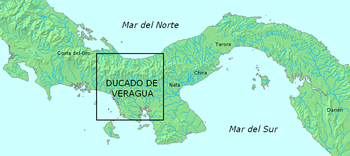- Duchy of Veragua
-
The Duchy of Veragua (Spanish: Ducado de Veragua) was a Spanish hereditary domain created in 1537 in the reign of King Charles I in a small section of the territory of Veragua (Gobernación de Veragua, which had been created in 1502 and extended along the Caribbean coasts of present-day Nicaragua, Costa Rica, and Panama as far to the east as the Río Belén). The first Duke of Veragua was Admiral Luis Colón y Toledo, grandson and heir of Christopher Columbus. The establishment of the duchy was the resolution of a longstanding dispute between the Spanish Crown and the heirs of Columbus, who had claimed a greater area. Luis Colón was also made Marquess of Jamaica.
The Dukedom was a perfect square of twenty-five leagues on a side, extending towards the west from the mouth of the Río Belén in the Caribbean, in what is today Panamanian territory. As Panama is less than twenty-five leagues in width at this point, the Duchy extended into the Pacific. By this circumstance, the area of the previous territorial division, Castilla de Oro, was split into two separated parts. The western part, from the Gulf of Nicoya to the border of the duchy, was united with Veragua Real (Royal Veragua) in 1540 to create the province of Nuevo Cartago y Costa Rica.
The first Duke of Veragua sent out various expeditions to try to enforce his authority throughout the territory, but they all resulted in disasters due to the resistance of the Indigenous peoples in their homeland and the difficulties of the topography and climate. In one of these expeditions the brother of the Duke, Francisco Colón, died at the hands of the natives.
In 1556 the Duke decided to return the domain to the Crown in exchange for an increased annual rent of 17,000 ducats (which was paid to his heirs up to 1898) and the retention of the title (which is still used in Spain). The current Duke of Veragua bears the same name as his ancestor, Cristóbal Colón.
In 1560 King Philip II created the Province of Veragua from the territory of the duchy, which was placed under the jurisdiction of the Royal Audiencia of Panama. This province corresponds approximately to the present-day Panamanian Veraguas Province.
Contents
List of Dukes of Veragua
From To Duke of Veragua 1509 1526 Diego Colón, 1st Duke of Veragua 1537 1572 Luis Colón de Toledo, 2nd Duke of Veragua 1572 1577 Felipa Colón de Toledo, 3rd Duchess of Veragua 1577 1626 Nuño Álvares Pereira Colón y Portugal, 4th Duke of Veragua 1626 1636 Álvaro Colón, 5th Duke of Veragua 1636 1673 Pedro Nuño Colón de Portugal, 6th Duke of Veragua 1673 1710 Pedro Manuel Colón de Portugal, 7th Duke of Veragua 1710 1733 Pedro Manuel Nuño Colón de Portugal, 8th Duke of Veragua 1733 1739 Catalina Ventura Colón de Portugal, 9th Duchess of Veragua 1739 1785 James Fitz-James Stuart, 10th Duke of Veragua 1785 1787 Carlos Fitz-James Stuart, 11th Duke of Veragua 1787 1821 Mariano Colón de Larreátegui y Ximénez de Embún, 12th Duke of Veragua 1821 1866 Pedro Colón y Ramirez de Baquedano, 13th Duke of Veragua 1866 1910 Cristobal Colón y de La Cerda, 14th Duke of Veragua 1910 1936 Cristóbal Colón y Aguilera, 15th Duke of Veragua 1936 1941 Ramon Colón de Carvajal, 16th Duke of Veragua 1941 1986 Vice Admiral Cristóbal Colón de Carvajal y Maroto, 17th Duke of Veragua 1986 Present Cristóbal Colón de Carvajal y Gorosábel, 18th Duke of Veragua See also
References
This article is a free translation of the article Ducado de Veragua at the Spanish Wikipedia.
External links
Categories:- Colonial Central America
- Colonial Panama
- History of Nicaragua
- History of Costa Rica
- Columbus family
- Dukes of Veragua
- Dukedoms of Spain
- Spanish colonization of the Americas
Wikimedia Foundation. 2010.

